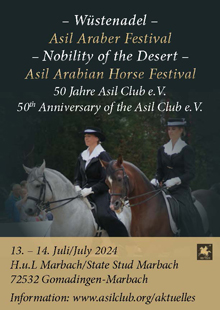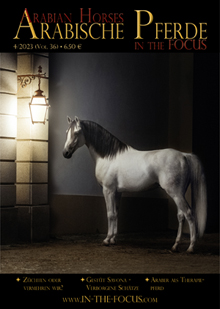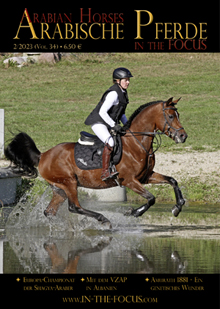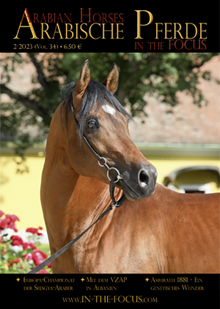During the “Open Day” at Katharinenhof Stud, Samatha Brooks of the University of Florida gave a very interesting presentation on modern genetics. To understand the novel options breeders may have in the future, one has to look at the basics of genetics first: The genome of a horse – or any other organism – contains the code of life. The majority of it is needed to support all the various functions of a cell, with many cells combining into tissue and ultimately building an organism. This “text” of a genome contains 2,7 billion individual pieces of genetic code, that transcribe into 20.000 genes, of which only about 3% have so far been decoded and understood. These genes determine, for example, height, coat color or genetic diseases, performance, etc. 97% of the “text” is not yet known, but it contains information on how, where, when a gene will function. Any gene can contain variations, resulting in traits like grey or non-grey, etc. It is presently possible to scientifically test for 16 different coat colors, 35 coat patterns, 14 traits of “qualities” such as movement and performance, 30 areas that are connected to diseases (e.g. SCID, CA, LFS), and 13 areas associated with complex diseases (OCD). Unfortunately, only few can so far be utilized by breeders, as they are not yet marketable.
Tradition vs. Genomics
The traditional way of using pedigree information and performance records to assess the value of the ancestry of a specific horse is a very inaccurate tool with regards to the breeding potential of that horse. This is not because these records may be wrong, but a pedigree describes only one theoretical option, while nature creates new life on the basis of probabilities. We all know, for example, that full siblings don’t necessarily look the same. This is due to the probability for each gene to have been contributed either from the sire or the dam. It is just a matter of chance, which gene was contributed by whom. With genomics, you can analyze and then visualize just how much genetic material originated with which parent. If, for example, you think about replacing the dam due to her age, and you have two fillies, full siblings, out of her, they look all the same by pedigree. But with genomics, you can determine which of the two daughters is more like her mother in her genetic make-up.
Another example is inbreeding. For many years, breeders and researchers have assessed the amount of inbreeding according to the pedigree and calculated a figure from that, the “inbreeding coefficient”. So the inbreeding coefficient is a term used to describe the degree of inbreeding in an individual. Now research has revealed that this is highly inaccurate: Samantha Brooks analyzed the Nagel herd with genomic measures but also calculated the inbreeding coefficients in the traditional way. The correlation between the pedigree-based degree of inbreeding and the actual DNA-calculated value of inbreeding was very low, which means that the traditional inbreeding coefficient is quite inaccurate.
The research group also measured the actual homozygosity of four full siblings (i.e. the percentage of homozygous alleles in the overall genome). Their homozygosity ranged between 61,6 % and 66,5%, i.e. they differed by almost 5%, although from the pedigree you would think they should be exactly the same. Although such a difference may not be crucial in one generation, it may well be important for a long-term breeding program. If you have a closed gene pool, such as the Straight Egyptians, diversity should be important. So, in case of these four full siblings, for which you need to decide which one to include in your breeding program, and assuming they are all equal in conformation, performance and other traits, you should choose the one with the higher diversity (lower homozygosity), as a higher diversity is beneficial for the overall health of your breeding program. This filly is going to be more reproductively healthy and to have a stronger immune system.
Origin of Bloodlines
After having analyzed many horses as a reference population, it is possible to examine the DNA of a horse and compare it to this reference population, and then determine the proportion of his ancestry. At first, the computer was asked to cluster the reference group into the most probable sub-groups based on their genome and not based on their pedigrees or their geographic origin! These clusters were then colored, to make them easier to differentiate. So this statistical procedure of clustering the horses based on their genome works without any prior knowledge derived from human history or pedigree – and that’s important! Only after these clusters were defined, the horses in these clusters were being looked at and allocated “labels” such as “Polish bloodlines” (yellow), “Egyptian bloodlines” (red), “American domestic” (blue), etc., according to their respective pedigree information. It turned out that most of the horses of each cluster had the same color (i.e. bloodline), with the one or the other odd exception.
Now, the result for a sample horse may be that 50 % of his ancestors can be attributed to the blue group, 25% to the yellow group and 25% to the red group. The result can be displayed in colorful bars for the breeder to easier understand.
The group of Samantha Brooks also used the same approach to examine four founder individuals of the Nagel herd. And the majority of the genomes were red (i.e. Straight Egyptians), as they should be. But even after 50 years of careful “Straight Egyptian” breeding, some colors of other ancestors were included, e.g. yellow, which was earlier identified as Polish. How come? Do these Straight Egyptians have some Polish blood? No. The problem is that it is not possible to date the common ancestor. It is therefore quite likely that this yellow bit in the Straight Egyptians, has a common ancestor with the foundation horses of the Polish breeding program, for example, the desert-bred imports that came to Poland in the course of time. If a relative of these desert imports went to Egypt, they both share common ancestry, hence it shows in the graph as yellow, as this ancestor was allocated to the Polish population. The “yellow group” is actually pieces of DNA that you find commonly in modern-day Polish Arabians, but 200 years ago, you probably found them in the Middle East and the Fertile Crescent. However, with the same method, it was possible to classify the Nagel herd as a cluster within the Egyptian cluster, defining it as a unique subgroup of the Straight Egyptians.
Conclusion
With genomics, it is now possible to analyze the genotype and thus predict the phenotype of a foal with regards to height, color, some individual performance traits, and genetic diseases. It will be possible in the future to have genotype records for frozen semen so that breeders can go shopping based on genotypes, rather than on pedigrees and performance records. If the mare is genotyped, too, you can search specifically for a suitable mating partner. You can test embryos by testing single cells before transfer, to determine their genotype and select the embryo that you want. This is the standard procedure world-wide in dairy and beef production, and commonly used. “Making breeding decisions based visually on phenotype or pedigree is very imprecise and was discarded 10-20 years ago in modern agricultural practices. Everything now is done by genetics. It has increased the accuracy by an enormous magnitude”, says Samantha Brooks.
So far, not many of these measures are used, and none anywhere near their potential or capacity. And although genomics is an intriguing science, it can be used and misused, just like any modern scientific advancements or inventions. Technically, everything is feasible, but not everything that is technically feasible is also reasonable to do, or morally permissible.
Gudrun Waiditschka













